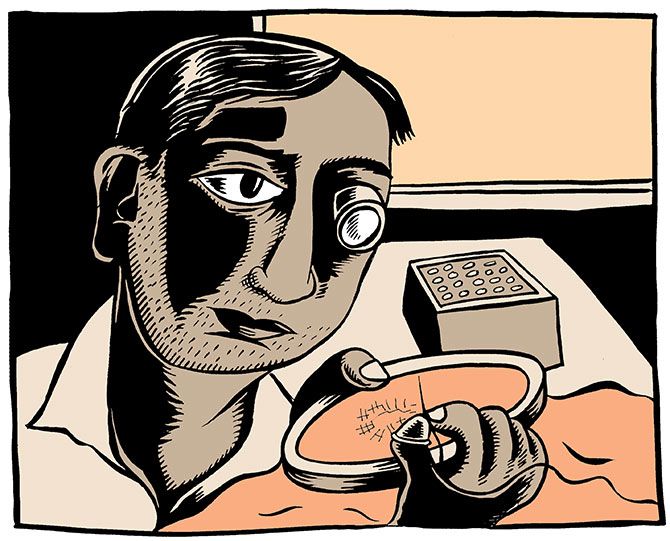 | « Back to article | Print this article |
'Our throwaway culture today has little room for mochis and rafoogars who concealed rips and tears with imperceptible stitches and great skill,' says Geetanjali Krishna.
Illustration: Uttam Ghosh/Rediff.com

The other day, when I was throwing out my daughter's torn jeans, I felt a pang of regret.
Not so long ago, we used to repair, reuse and recycle every single thing in the house, and threw it out only when there was absolutely no life left in it.
Yellowing bath towels would be reused as kitchen towels, then as dusters, and finally, as mops. Then, when they became threadbare and brown, they were finally discarded with the satisfaction that their existence had been a productive one.
Today, however, people have neither time nor inclination to repair and reuse. What's more, the people who effected these repairs -- cobblers, backyard tailors and rafoogars -- are no longer easy to find.
The first time I saw the work of a master rafoogar was when I was a teenager in Lucknow. At that time, rafoogari, the traditional craft of darning which repaired and gave new life to old textiles, had a lot of patrons.
Just as everyone had their favourite dhobi, the washerman who crinkled the sleeves of crisp chikan kurtas just so, textile collectors also had their favourite rafoogar.
An aunt discovered her prized antique pashmina shawl had developed some holes and asked me to come along to give it for rafoo.
The tiny, bespectacled man was bent over a silk sari. His fine needle flew in and out of the rent in the fabric, seemingly weaving rather than stitching its edges together.
How did he manage to make his stitches disappear, I asked in wonder?
He replied that he'd learnt the art from his father when he was small: "The trick is in making really tiny stitches and blending them with the fabric," he told me.
When his father had found that his eyesight wasn't as good as it once was, he began to use a magnifying glass to work with.
"My eyes are failing too, and I use my father's magnifying glass now," the old man said. "But my clients don't want to let me go."
Cobblers too were similarly patronised. Often, they would go from door to door in a neighbourhood, polishing, stitching and resoling the shoes of the entire household.
I had one such person coming home till a few years ago, who took great pride in his work. When he re-soled a shoe, he'd work painstakingly to blend the shade of the new sole with the old leather, so that the two melded seamlessly together.
"See?" he'd say proudly brandishing a freshly repaired shoe, "you'll never be able to tell that these shoes have been repaired because my stitches are completely invisible."
At some point, the cobbler stopped coming to my house. I never found out why, and we fell into the mindless pattern of discarding broken footwear.
Our throwaway culture today has little room for mochis and rafoogars who concealed rips and tears with imperceptible stitches and great skill.
Ironically, their desire to cast that invisibility cloak on all their repairs has made their contributions that much harder to see.
What else can one expect when the hallmark of a master rafoogar is that he leaves no mark on his work?
I recently read an article on Kintsugi, the Japanese art of repairing broken pottery with gold-dusted lacquer. The fractures, joined together with golden lacquer, become focal points in the repaired piece instead of being made to disappear -- and the final result is often even more beautiful than it looked when it had been perfect and whole.
Perhaps, like the Japanese, we need to rethink our quest for perfection and learn to re-value the old, the scarred and the repaired —- as we once did.